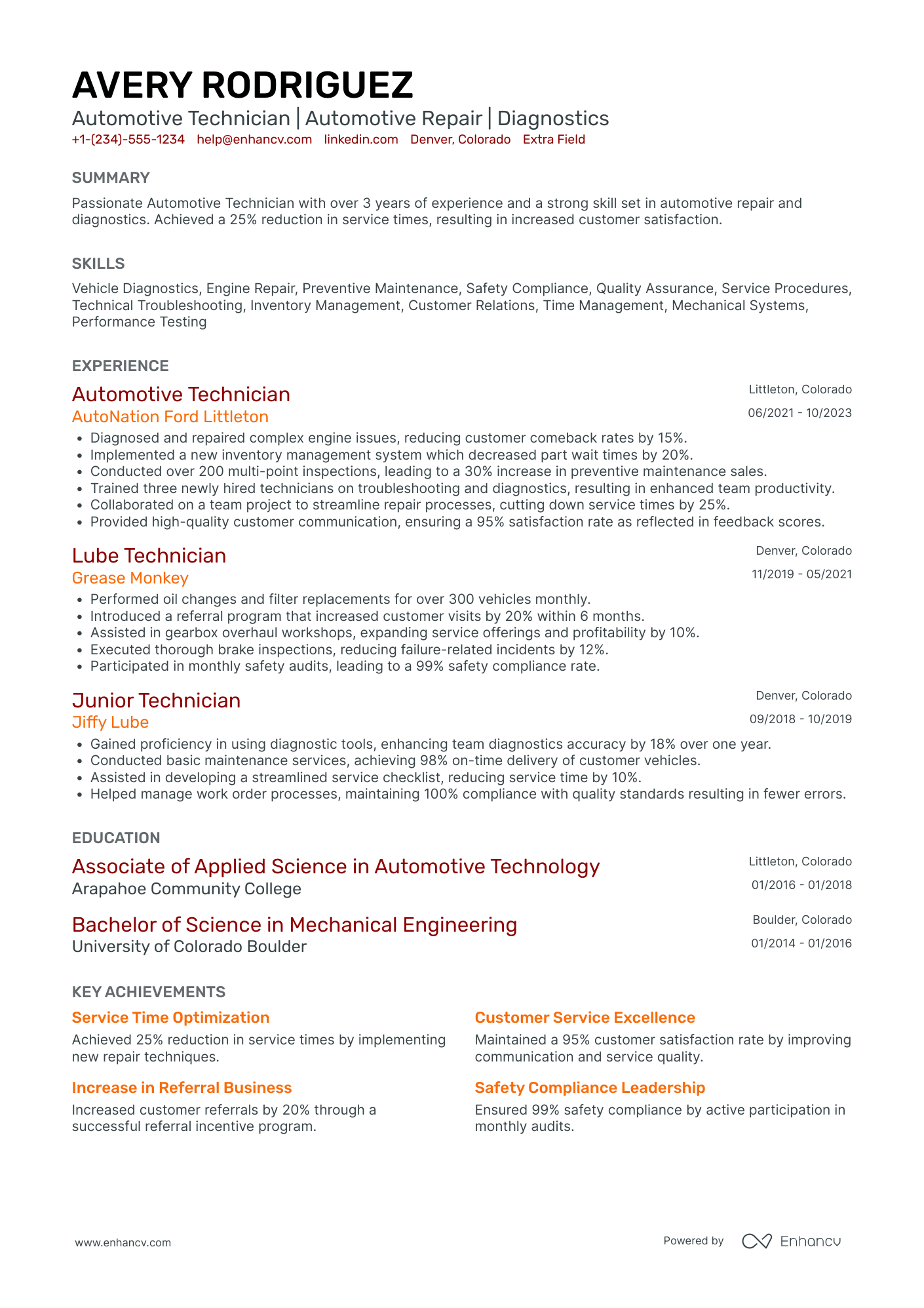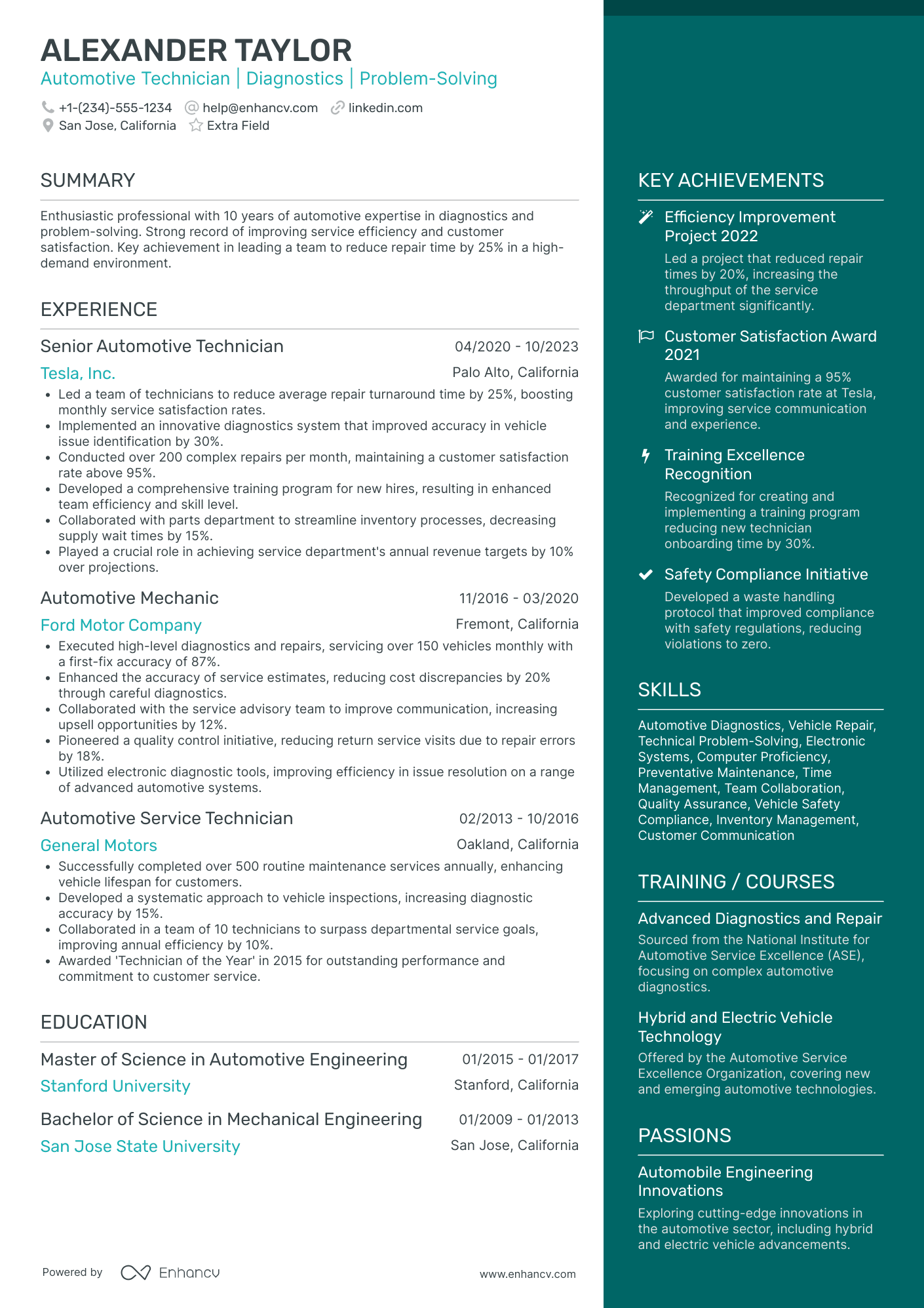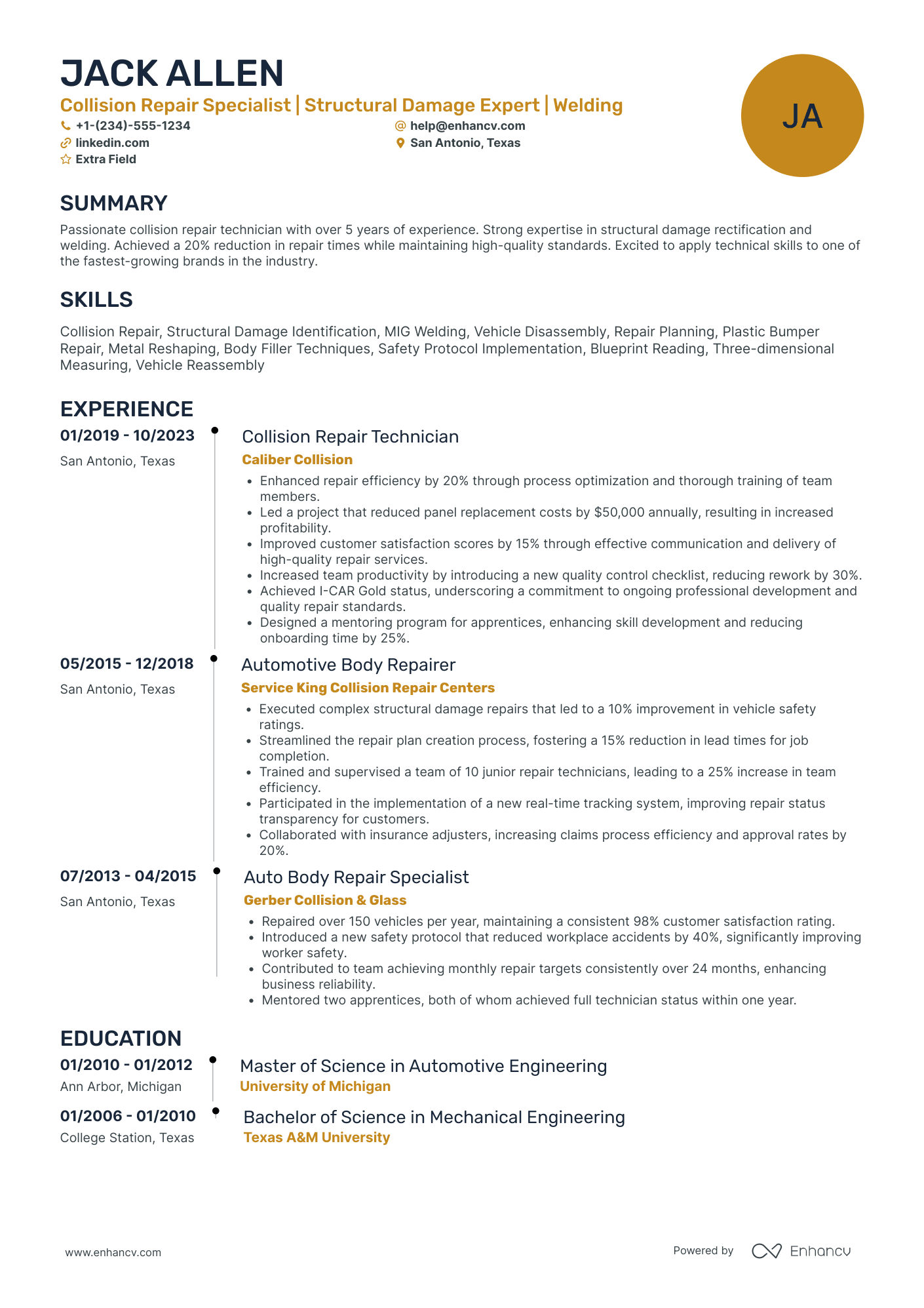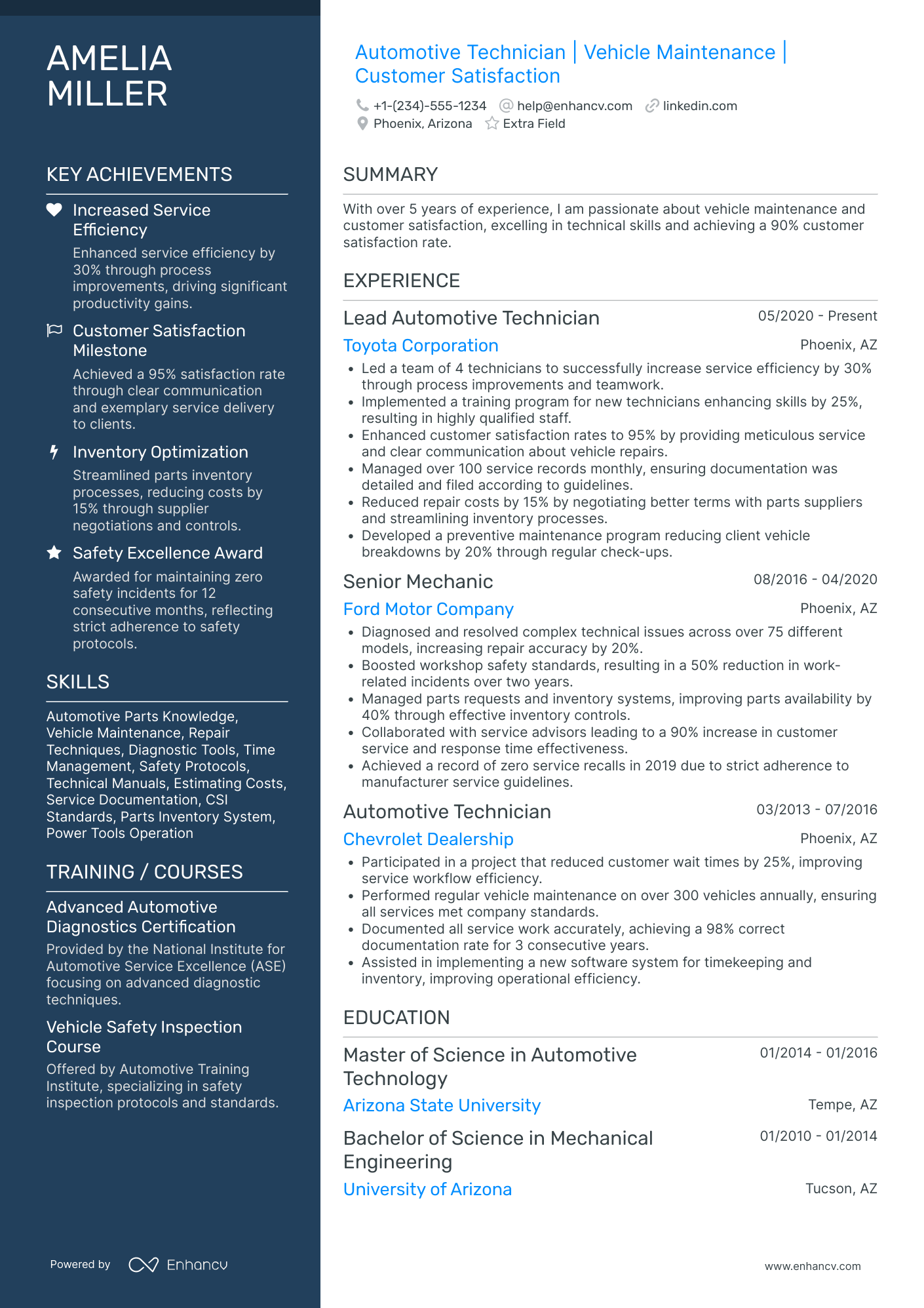As an automotive technician, effectively conveying the breadth of your hands-on experience and technical certifications on a resume can be a daunting challenge. Our comprehensive guide is designed to help you articulate your expertise and qualifications clearly, ensuring your resume stands out to potential employers.
- Defining the highlights of your automotive technician career through your resume summary, objective, and experience.
- Real-world automotive technician resume samples with best practices on how to stand out amongst the endless pile of candidate resumes.
- Most in-demand automotive technician resume skills and certifications across the industry.
- Standardizing your resume layout, while maintaining your creativity and individuality.
If the automotive technician resume isn't the right one for you, take a look at other related guides we have:
Optimize your automotive technician resume format to pass the recruiters' assessment
You may be wondering just how much time you need to spend on designing your automotive technician resume.
What recruiters are looking for is systematised content that is clear and coherent. Thus, your automotive technician resume needs to answer requirements and why you're the best candidate for the role from the get-go.
Often, a clear layout consists of:
- Sorting your experience in the reverse chronological order - starting with your most recent and relevant roles. This is an excellent choice for more experienced professionals;
- Writing your contact information (e.g. personal phone number and email address) and your portfolio or LinkedIn link in your automotive technician resume header. If you're wondering to include a photo or not, always make sure that it's appropriate for the country you're applying in;
- Use the basic, most important automotive technician resume sections - your experience, education, summary, etc. Use your resume's real estate wisely to tell a compelling, professional story and match job description's keywords;
- Don't go overboard with the length of your resume. One page is absolutely fine if you happen to have under a decade of relevant experience.
Are you still wondering if you should submit your automotive technician resume in PDF or Word format ? The PDF has a few more advantages, as it doesn't change the format and the text can't be altered upon application.
Format matters most when your automotive technician resume is assessed by the Applicant Tracker System (or the ATS).
The ATS parses resumes, looking for specific keywords, skills or experience that match the job description.
P.S. We recently did a study on how the ATS works and were able to demystify three of the biggest misconceptions about how it assesses candidate resumes.
To pass the ATS evaluation, select any of the serif or sans-serif fonts. Popular choices that would help your automotive technician resume stand out include Raleway, Exo 2, Montserrat, etc.
Most traditionalists go for Arial or Times New Roman, but it's often the case that many candidates choose these fonts, and you'd thus lose points on the uniqueness front.
Think about the market’s preferences – a Canadian resume, for instance, could have a different layout.
Upload & Check Your Resume
Drop your resume here or choose a file. PDF & DOCX only. Max 2MB file size.
PRO TIP
Always remember that your automotive technician certifications can be quantified across different resume sections, like your experience, summary, or objective. For example, you could include concise details within the expertise bullets of how the specific certificate has improved your on-the-job performance.
Don't forget to include these six sections on your automotive technician resume:
- Header and summary for your contact details and to highlight your alignment with the automotive technician job you're applying for
- Experience section to get into specific technologies you're apt at using and personal skills to deliver successful results
- Skills section to further highlight how your profile matches the job requirements
- Education section to provide your academic background
- Achievements to mention any career highlights that may be impressive, or that you might have missed so far in other resume sections
What recruiters want to see on your resume:
- ASE certification or equivalent automotive technical qualifications.
- Hands-on experience with diagnostic and repair tools specific to the automotive industry (e.g., OBD scanners, multimeters, engine analyzers).
- Proficiency in various repair techniques including engine, transmission, electrical, and HVAC systems.
- Experience with different vehicle makes and models, including knowledge of manufacturer-specific systems.
- Examples of excellent customer service skills, like effective communication and the ability to explain complex technical issues in understandable terms.
Guide to your most impressive automotive technician resume experience section
When it comes to your resume experience , stick to these simple, yet effective five steps:
- Show how your experience is relevant by including your responsibility, skill used, and outcome/-s;
- Use individual bullets to answer how your experience aligns with the job requirements;
- Think of a way to demonstrate the tangible results of your success with stats, numbers, and/or percentages ;
- Always tailor the experience section to the automotive technician role you're applying for - this may sometimes include taking out irrelevant experience items;
- Highlight your best (and most relevant) achievements towards the top of each experience bullet.
You're not alone if you're struggling with curating your experience section. That's why we've prepared some professional, real-life automotive technician resume samples to show how to best write your experience section (and more).
- Led a team of 5 technicians in performing diagnostics and repairs on over 1200 vehicles, achieving a customer satisfaction rate of 96%.
- Spearheaded the implementation of a new inventory management system, reducing parts waste by 20% and saving the company an estimated $50,000 annually.
- Developed a comprehensive training program for new hires which decreased the onboarding time by 30% and improved the repair quality and speed.
- Diagnosed and repaired electrical and mechanical issues in over 800 vehicles with a focus on timely turnaround, averaging 25 vehicles serviced per week.
- Managed a refurbishment project for 50 fleet vehicles that improved fuel efficiency by 15%, significantly lowering operational costs for the client.
- Contributed to revamping the service department's scheduling process, leading to a 10% increase in daily workflow efficiency.
- Implemented advanced diagnostic techniques for hybrid and electric vehicles that expanded the service offerings, resulting in a 25% increase in revenue from EV services.
- Mentored 7 junior mechanics, improving overall team performance and reducing errors by 18% over a 12-month period.
- Engineered a cost-saving strategy by negotiating with parts suppliers, cutting annual expenses by $30,000 without compromising on quality.
- Direct involvement in the repair and maintenance of approximately 1400 diesel vehicles, consistently maintaining a 'zero downtime' metric for high-priority fleet clients.
- Collaborated on the development and launch of a proprietary software for tracking vehicle service history, increasing repeat business by 20% due to improved customer trust and engagement.
- Created and enforced stringent safety protocols that led to a 35% reduction in workplace accidents.
- Efficiently diagnosed and facilitated the repair of over 500 complex drivetrain and powertrain systems, enhancing vehicle performance and longevity.
- Championed a customer review initiative that improved the service department's online rating from 4.0 to 4.7 stars on Google within a year.
- Led monthly in-house workshops on automotive best practices, elevating the expertise of the team, and resulting in a 15% increase in upsell services.
- Managed and executed the calibration and maintenance of advanced sensor systems in over 600 modern vehicles, ensuring compliance with state and federal emissions standards.
- Played a pivotal role in growing the business through exceptional service delivery, contributing to a doubling of the customer base in 4 years.
- Optimized shop operation workflows, which resulted in a 20% increase in work order completions per month.
- Orchestrated full-scale vehicle inspections and optimizations, servicing over 1150 vehicles to surpass customer reliability and safety expectations.
- Implemented an eco-friendly waste disposal program that reduced hazardous waste by 40% while saving the shop $10,000 annually in disposal fees.
- Authored a monthly newsletter on vehicle maintenance tips, which successfully engaged clients and increased return visits by 25%.
- Customized and fine-tuned performance vehicles, resulting in an average horsepower increase of 20% across enhanced vehicles.
- Contributed to the adoption of new tire installation equipment, decreasing average installation time by 15 minutes per tire, boosting daily service capacity.
- Coordinated with the sales team to deliver accurate and understandable vehicle health reports to customers, increasing parts and service sales by 18%.
The following content includes information from "O*NET OnLine" by the U.S. Department of Labor, Employment and Training Administration (USDOL/ETA). Used under the CC BY 4.0 license. The data represents the top responsibilities present on the task lists for automotive technician professionals.
Top Responsibilities for Automotive Technician:
- Install equipment and accessories, such as stereos, navigation equipment, communication equipment, and security systems.
- Inspect and test electrical or electronic systems to locate and diagnose malfunctions, using visual inspections and testing instruments, such as oscilloscopes and voltmeters.
- Cut openings and drill holes for fixtures and equipment, using electric drills and routers.
- Splice wires with knives or cutting pliers, and solder connections to fixtures and equipment.
- Diagnose or repair problems with electronic equipment, such as sound, navigation, communication, and security equipment, in motor vehicles.
- Run new speaker and electrical cables.
- Confer with customers to determine the nature of malfunctions.
- Remove seats, carpeting, and interiors of doors and add sound-absorbing material in empty spaces, reinstalling interior parts.
- Record results of diagnostic tests.
- Estimate costs of repairs, based on parts and labor charges.
Quantifying impact on your resume
- State the number of years of experience in automotive repair and maintenance to demonstrate tenure and expertise.
- Specify the number of vehicle models you are proficient with to show versatility and broad knowledge.
- Highlight the percentage increase in efficiency or productivity due to process improvements you implemented.
- Mention the number of diagnostic and repair tools you are skilled in operating to showcase technical competencies.
- Quantify the number of customers served or repeat business you helped to secure to reflect customer satisfaction and loyalty.
- Include the size of teams you've led or collaborated with to indicate leadership and teamwork capabilities.
- Report any reduction in service times or costs you've achieved to emphasize efficiency and cost-effectiveness.
- Detail the volume of repairs or services performed to demonstrate work capacity and dependability.
Action verbs for your automotive technician resume
Remember these four tips when writing your automotive technician resume with no experience
You've done the work - auditing the job requirements for keywords and have a pretty good idea of the skill set the ideal candidate must possess.
Yet, your professional experience amounts to a summer internship .
Even if you have limited or no professional expertise that matches the role you're applying for, you can use the resume experience section to:
- List extracurricular activities that are relevant to the job requirements. Let's say you were editor-in-chief of your college newspaper or part of the engineering society. Both activities have taught you invaluable, transferrable skills (e.g. communication or leadership) that can be crucial for the job;
- Substitute jobs with volunteer experience. Participating in charity projects has probably helped you develop an array of soft skills (e.g. meeting deadlines and interpersonal communications). On the other hand, volunteering shows potential employers more about you: who you are and what are the causes you care about;
- Align job applications with your projects. Even your final-year thesis work could be seen as relevant experience, if it's in the same industry as the job you're applying for. Ensure you've listed the key skills your project has taught you, alongside tangible outcomes or your project success;
- Shift the focus to your transferrable skills. We've said it before, but recruiters will assess your profile upon both job requirements and the skills you possess. Consider what your current experience - both academic and life - has taught you and how you've been able to develop your talents.
Recommended reads:
PRO TIP
If you're in the process of obtaining your certificate or degree, list the expected date you're supposed to graduate or be certified.
Automotive technician resume skills section: writing about your hard skills and soft skills
Recruiters always care about the skill set you'd bring about to the automotive technician role. That's why it's a good idea to curate yours wisely, integrating both hard (or technical) and soft skills. Hard skills are the technology and software you're apt at using - these show your suitability for the technical aspect of the role. They are easy to track via your experience, certifications, and various resume sections. Your soft skills are those personality traits you've gained over time that show how you'd perform in the specific team, etc. Soft skills are more difficult to qualify but are definitely worth it - as they make you stand out and show your adaptability to new environments. How do you build the skills section of your resume? Best practices point that you could:
- Include up to five or six skills in the section as keywords to align with the advert.
- Create a specific technical skills section to highlight your hard skills aptitude.
- Align the culture of the company you're applying to with your soft skills to determine which ones should be more prominent in your skills section.
- Make sure you answer majority of the job requirements that are in the advert within your skills section.
A automotive technician's resume requires a specific skill set that balances both industry-specific hard skills with personal, soft skills. Discover the perfect mix for the automotive technician role from our list:
Top skills for your automotive technician resume:
Diagnostic Tools
Engine Repair
Brake Systems
Electrical Systems
Suspension Systems
Transmission Repair
Fuel Injection Systems
Computerized Diagnostic Equipment
Welding
Air Conditioning Systems
Problem-Solving
Attention to Detail
Communication
Teamwork
Time Management
Customer Service
Adaptability
Critical Thinking
Mechanical Aptitude
Work Ethic
Next, you will find information on the top technologies for automotive technician professonals from "O*NET OnLine" by the U.S. Department of Labor, Employment and Training Administration (USDOL/ETA). Used under the CC BY 4.0 license.
Top technologies for Automotive Technician’s resume:
- Microsoft Excel
- Microsoft PowerPoint
- Harris Tech X.over Pro
- True Audio WinSpeakerz
PRO TIP
The more trusted the organization you've attained your certificate (or degree) from, the more credible your skill set would be.
Automotive technician-specific certifications and education for your resume
Place emphasis on your resume education section . It can suggest a plethora of skills and experiences that are apt for the role.
- Feature only higher-level qualifications, with details about the institution and tenure.
- If your degree is in progress, state your projected graduation date.
- Think about excluding degrees that don't fit the job's context.
- Elaborate on your education if it accentuates your accomplishments in a research-driven setting.
On the other hand, showcasing your unique and applicable industry know-how can be a literal walk in the park, even if you don't have a lot of work experience.
Include your accreditation in the certification and education sections as so:
- Important industry certificates should be listed towards the top of your resume in a separate section
- If your accreditation is really noteworthy, you could include it in the top one-third of your resume following your name or in the header, summary, or objective
- Potentially include details about your certificates or degrees (within the description) to show further alignment to the role with the skills you've attained
- The more recent your professional certificate is, the more prominence it should have within your certification sections. This shows recruiters you have recent knowledge and expertise
At the end of the day, both the education and certification sections hint at the initial and continuous progress you've made in the field.
And, honestly - that's important for any company.
Below, discover some of the most recent and popular automotive technician certificates to make your resume even more prominent in the applicant pool:
The top 5 certifications for your automotive technician resume:
- Automotive Service Excellence (ASE) - National Institute for Automotive Service Excellence
- Master Automobile Technician Certification (Master Tech) - National Institute for Automotive Service Excellence
- Advanced Engine Performance Specialist Certification (L1) - National Institute for Automotive Service Excellence
- Undercar Specialist Exhaust Systems (X1) - National Institute for Automotive Service Excellence
- Certified automotive technician (CAT) - National automotive technicians Education Foundation (NATEF)
The content below includes information from "O*NET OnLine" by the U.S. Department of Labor, Employment and Training Administration (USDOL/ETA). Used under the CC BY 4.0 license. The data represents the top associations for automotive technician professionals.
Top US associations for a Automotive Technician professional
- International Society of Certified Electronics Technicians
- National Institute for Automotive Service Excellence
- The Mobile Electronics Certified Professional
PRO TIP
The more trusted the organization you've attained your certificate (or degree) from, the more credible your skill set would be.
Recommended reads:
Which one to use: a resume summary or a resume objective?
The automotive technician resume summary or objective serves as a good introduction to your experience for recruiters.
Have you ever wondered which one (the summary or objective) will be more appropriate for your automotive technician resume?
- If you are a less experienced professional, write a resume objective statement. The objective is about three sentences long and provides recruiters with information about your career goals, strengths, and achievements . It should basically denote how you see yourself in this particular role, and what is your relevant experience and/or know-how;
- If you happen to have plenty of relevant experience, select your most impressive achievements for your resume summary. The summary is no longer than five sentences and serves as a storytelling instrument - highlighting your greatest career wins . Don't forget to align your summary with the job requirements to ensure your resume stays relevant to the role.
Read on for more information and examples of resume summaries and objectives from real world professionals.
Resume summaries for a automotive technician job
- Seasoned automotive technician with over 10 years of experience in diagnostics, repairs, and routine maintenance. Skilled in utilizing modern diagnostic technology to quickly identify vehicle issues, streamline the repair process, and enhance customer satisfaction. Recognized for excellence in leading a team of junior technicians at a busy urban dealership to achieve a 20% increase in efficiency.
- Dedicated Mechanical Engineer transitioning into the automotive sector, bringing a strong foundation in mechanical systems, CAD software proficiency, and a keen interest in leveraging engineering principles to improve vehicle performance. Eager to apply skills to enhance repair quality and contribute to a reputable workshop's service standards.
- Highly skilled Electrician making a career shift into automotive technology, offering extensive knowledge of electrical systems and a successful track record of problem-solving complex circuitry issues. Passionate about electric vehicles and committed to contributing to the future of sustainable automotive solutions.
- Adept at handling high-volume workloads, a former Aerospace Technician pivots towards automotive repair, eager to bring a meticulous approach to vehicle systems and a passion for mechanical innovation. Excited to apply aeronautical precision to ensure superior vehicle performance and customer contentment in an automotive workshop environment.
- Objective: Aspiring automotive technician ready to embark on a professional journey, aiming to develop hands-on expertise in vehicle repair and maintenance. Committed to learning from seasoned professionals and dedicated to gaining certifications necessary for advancement. Enthusiastic about contributing to a service team through hard work and a quick-learning attitude.
- Objective: Motivated individual with a strong interest in automotive technology seeks to establish a career as a Technician. With no prior experience but a solid foundation in customer service and a genuine passion for cars, eager to acquire technical skills and deliver exceptional service quality while advancing personal mastery and professional growth.
Optimize your resume summary and objective for ATS
Drop your resume here or choose a file.
PDF & DOCX only. Max 2MB file size.
Average salary info by state in the US for automotive technician professionals
Local salary info for Automotive Technician.” Source: My Next Move, National Center for O*NET Development. Accessed 10/15/2024
| State | Average Salary (in USD) |
|---|---|
| US National Average | $45,570 |
| California (CA) | $46,490 |
| Texas (TX) | $48,730 |
| Florida (FL) | $45,340 |
| New York (NY) | $48,600 |
| Pennsylvania (PA) | $44,510 |
| Illinois (IL) | $45,200 |
| Ohio (OH) | $47,810 |
| Georgia (GA) | $42,380 |
| North Carolina (NC) | $39,200 |
| Michigan (MI) | $47,990 |
Recruiters' favorite additional automotive technician resume sections
When writing your automotive technician resume, you may be thinking to yourself, " Is there anything more I can add on to stand out? ".
Include any of the below four sections you deem relevant, to ensure your automotive technician resume further builds up your professional and personal profile:
Key takeaways
- Ensure your automotive technician resume uses a simple, easy-to-read format that reflects upon your experience and aligns with the role;
- Be specific within the top one-third of your resume (header and summary or objective) to pinpoint what makes you the ideal candidate for the automotive technician role;
- Curate information that is tailored to the job by detailing skills, achievements, and actual outcomes of your efforts;
- List your certifications and technical capabilities to demonstrate your aptitude with specific software and technologies;
- The sections you decide on including on your automotive technician should pinpoint your professional expertise and personality.
Automotive Technician resume examples
By Experience
By Role
































